Search Result
Results for "
Docosahexaenoic Acid
" in MedChemExpress (MCE) Product Catalog:
2
Biochemical Assay Reagents
11
Isotope-Labeled Compounds
| Cat. No. |
Product Name |
Target |
Research Areas |
Chemical Structure |
-
- HY-B2167
-
-
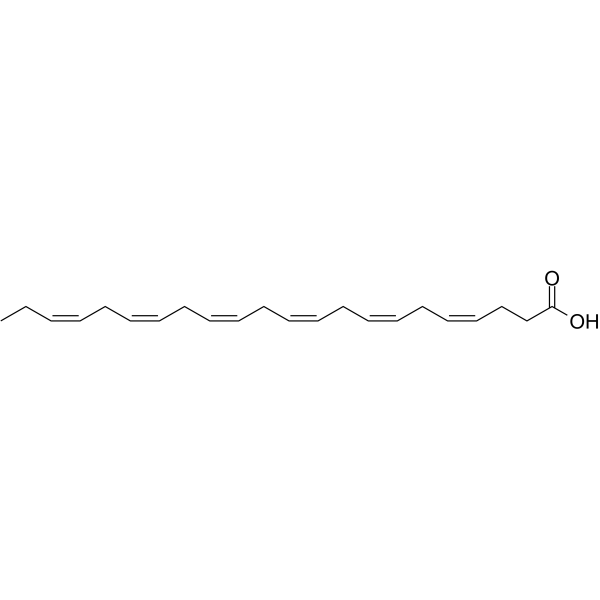
-
- HY-107343
-
|
Ethyl docosahexaenoate
|
Others
|
Neurological Disease
Metabolic Disease
|
|
Docosahexaenoic acid ethyl ester (Ethyl docosahexaenoate) is a 90% concentrated ethyl ester of docosahexaenoic acid manufactured from the microalgal oil. Docosahexaenoic acid ethyl ester enhances 6-hydroxydopamine-induced neuronal damage by induction of lipid peroxidation in mouse striatum. Docosahexaenoic acid (DHA) is a key component of the cell membrane, and its peroxidation is inducible due to the double-bond chemical structure. Docosahexaenoic acid has neuroprotective effects .
|
-
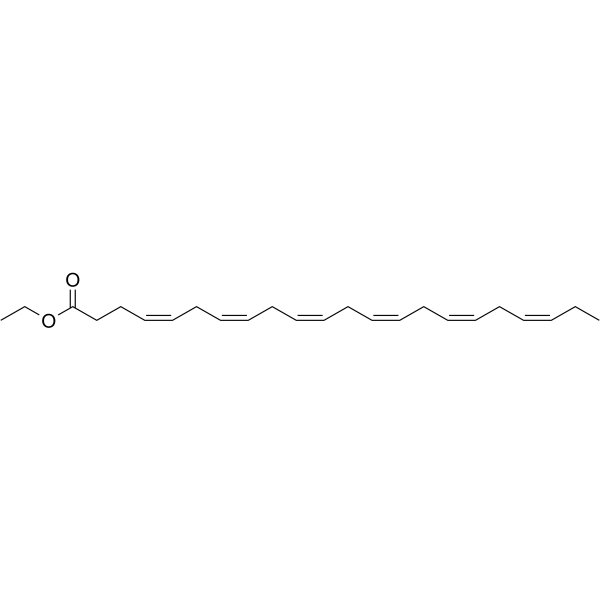
-
- HY-101541
-
|
Methyl docosahexaenoate; all cis-DHA methyl ester
|
Others
|
Neurological Disease
|
|
Docosahexaenoic Acid methyl ester is a methylated docosahexaenoic acid analog which can be intercalated into membrane phospholipids without being oxidized or hydrolyzed.
|
-

-
- HY-B2167S1
-
|
|
Endogenous Metabolite
|
Neurological Disease
|
|
Docosahexaenoic acid- 13C22 is the 13C labeled Docosahexaenoic acid[1]. Docosahexaenoic Acid (DHA) is an omega-3 fatty acid abundantly present brain and retina. It can be obtained directly from fish oil and maternal milk[2][3][4][5][6].
|
-
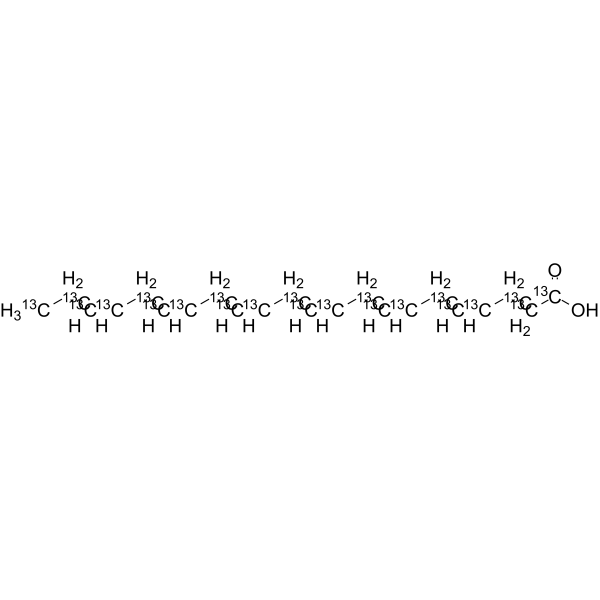
-
- HY-107343S
-
|
Ethyl docosahexaenoate-d5
|
Isotope-Labeled Compounds
|
Neurological Disease
Metabolic Disease
|
|
Docosahexaenoic acid ethyl ester-d5 is the deuterium labeled Docosahexaenoic acid ethyl ester. Docosahexaenoic acid ethyl ester (Ethyl docosahexaenoate) is a 90% concentrated ethyl ester of docosahexaenoic acid manufactured from the microalgal oil. Docosahexaenoic acid ethyl ester enhances 6-hydroxydopamine-induced neuronal damage by induction of lipid peroxidation in mouse striatum. Docosahexaenoic acid (DHA) is a key component of the cell membrane, and its peroxidation is inducible due to the double-bond chemical structure. Docosahexaenoic acid has neuroprotective effects[1][2].
|
-

-
- HY-107343S1
-
|
Ethyl docosahexaenoate-d5-1
|
Isotope-Labeled Compounds
|
Others
|
|
Docosahexaenoic acid ethyl ester-d5-1 is the deuterium labeled Docosahexaenoic acid ethyl ester. Docosahexaenoic acid ethyl ester (Ethyl docosahexaenoate) is a 90% concentrated ethyl ester of docosahexaenoic acid manufactured from the microalgal oil. Docosahexaenoic acid ethyl ester enhances 6-hydroxydopamine-induced neuronal damage by induction of lipid peroxidation in mouse striatum. Docosahexaenoic acid (DHA) is a key component of the cell membrane, and its peroxidation is inducible due to the double-bond chemical structure. Docosahexaenoic acid has neuroprotective effects[1][2][3].
|
-

-
- HY-B2167S
-
|
DHA-d5; Cervonic Acid-d5
|
Endogenous Metabolite
|
Neurological Disease
|
|
Docosahexaenoic acid-d5 is the deuterium labeled Docosahexaenoic Acid. Docosahexaenoic Acid (DHA) is an omega-3 fatty acid abundantly present brain and retina. It can be obtained directly from fish oil and maternal milk.
|
-
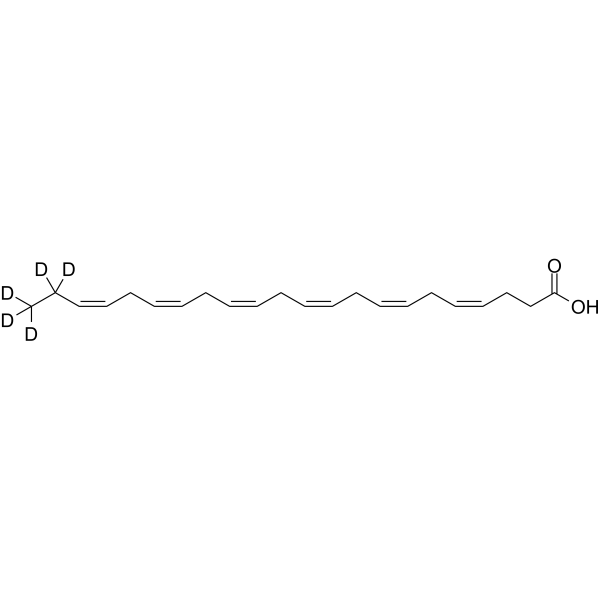
-
- HY-101541S
-
|
Methyl docosahexaenoate-d5; all cis-DHA methyl ester-d5
|
Isotope-Labeled Compounds
|
Neurological Disease
|
|
Docosahexaenoic acid-d5 methyl ester is the deuterium labeled Docosahexaenoic Acid methyl ester. Docosahexaenoic Acid methyl ester is a methylated docosahexaenoic acid analog which can be intercalated into membrane phospholipids without being oxidized or hydrolyzed[1][2].
|
-

-
- HY-101541S1
-
|
Methyl docosahexaenoate-13C22; all cis-DHA methyl ester-13C22
|
Isotope-Labeled Compounds
|
Others
|
|
Docosahexaenoic acid- 13C22 methyl ester is the 13C22 labeled Docosahexaenoic acid methyl ester (HY-101541)[1].
|
-
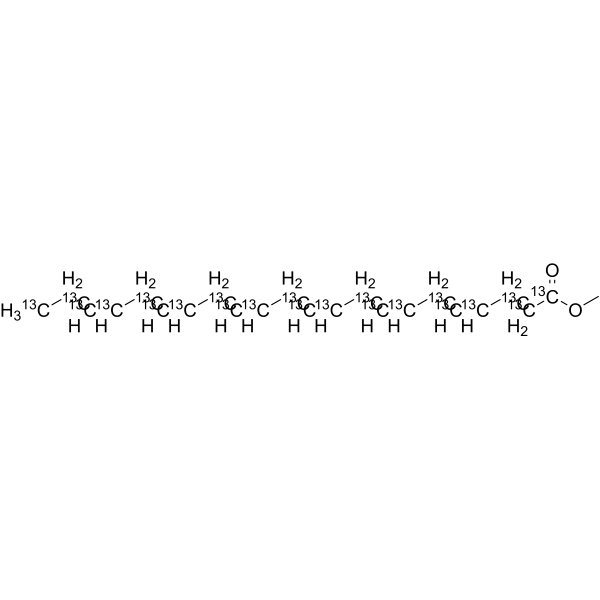
-
- HY-124019
-
-
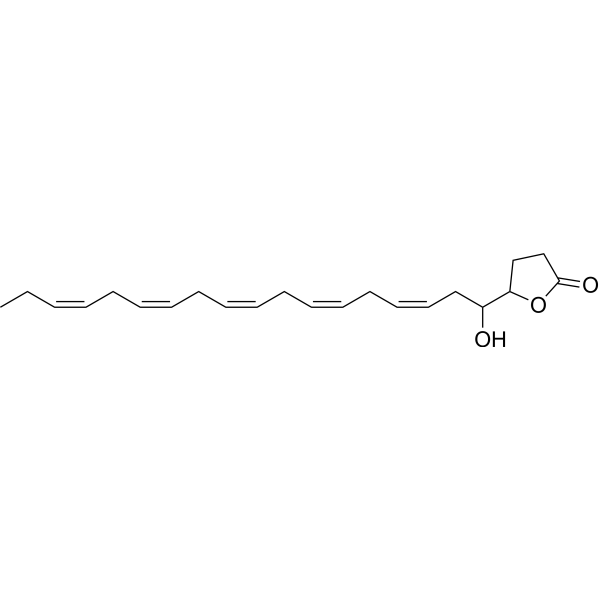
-
- HY-130550
-
-
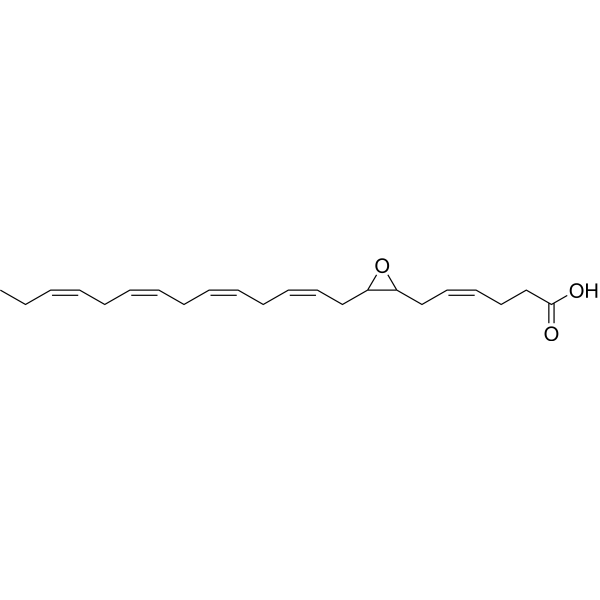
-
- HY-157690
-
|
|
Others
|
Others
|
|
19(S),20(R)-EDP is an epoxidized metabolite of docosahexaenoic acid (HY-B2167) .
|
-

-
- HY-157690A
-
|
|
Others
|
Others
|
|
19(R),20(S)-EDP (compound 19(S),20(R)-2a) is an oxylipin and a metabolite of docosahexaenoic acid (HY-B2167) .
|
-
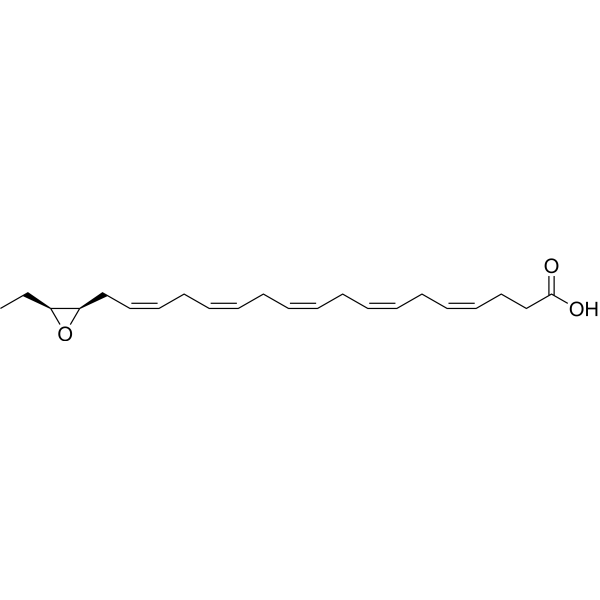
-
- HY-130289
-
|
4-Hydroxy Docosahexaenoic Acid; (±)4-HDoHE
|
PPAR
|
Metabolic Disease
Inflammation/Immunology
|
|
(±)4-HDHA (4-Hydroxy docosahexaenoic acid) is an autoxidation product of Docosahexaenoic acid (HY-B2167) (DHA). (±)4-HDHA is a PPARγ agonist, antidiabetic and anti-inflammatory agent .
|
-

-
- HY-120178
-
|
|
Others
|
Cardiovascular Disease
|
|
(±)7(8)-DiHDPA is a epoxygenase metabolite of docosahexaenoic acid (HY-B2167). (±)7(8)-DiHDPA inhibits platelet aggregation at concentrations below those affecting thromboxane synthesis .
|
-
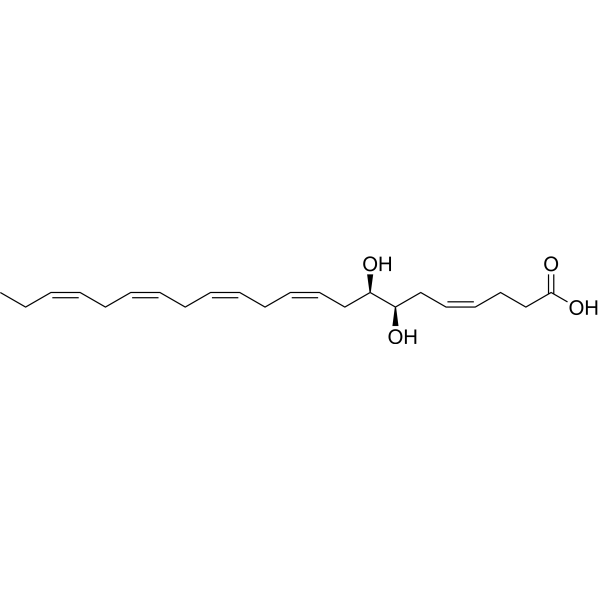
-
- HY-120442
-
|
|
Others
|
Cardiovascular Disease
|
|
(±)16(17)-DiHDPA is a epoxygenase metabolite of docosahexaenoic acid (HY-B2167). (±)16(17)-DiHDPA inhibits platelet aggregation at concentrations below those affecting thromboxane synthesis .
|
-
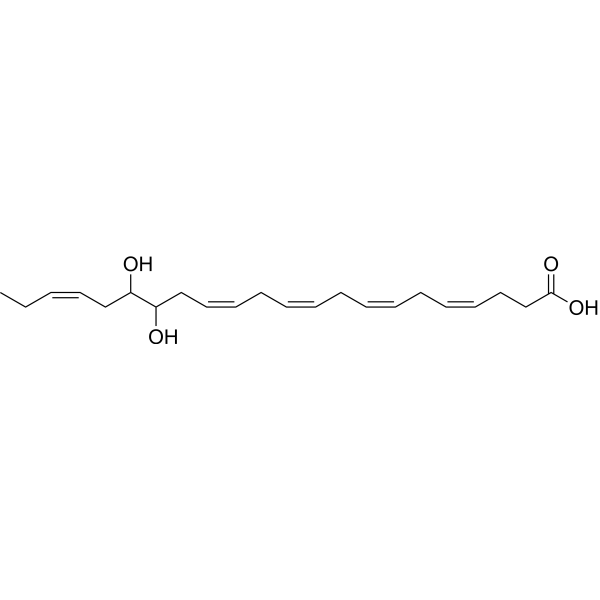
-
- HY-130239A
-
|
(±)14-HDoHE; 14-hydroxy Docosahexaenoic Acid; (±)14-HDoHE
|
Drug Metabolite
|
Neurological Disease
|
|
(±)14-HDHA is the isomer of 14(S)-HDHA (HY-130239). 14(S)-HDHA is an oxygenation product of Docosahexaenoic acid (DHA). 14(S)-HDHA is a marker reflecting activation of a Docosahexaenoic acid carbon 14-lipoxygenation pathway .
|
-

-
- HY-130419
-
|
13,14-EpDPE
|
Others
|
Cardiovascular Disease
Neurological Disease
|
|
(±)13(14)-EpDPA (13,14-EpDPE) is the product of the reaction of cytochrome P-450 epoxygenase with Docosahexaenoic Acid (DHA).(±)13(14)-EpDPA has antihyperalgesic and vasorelaxative activities .
|
-
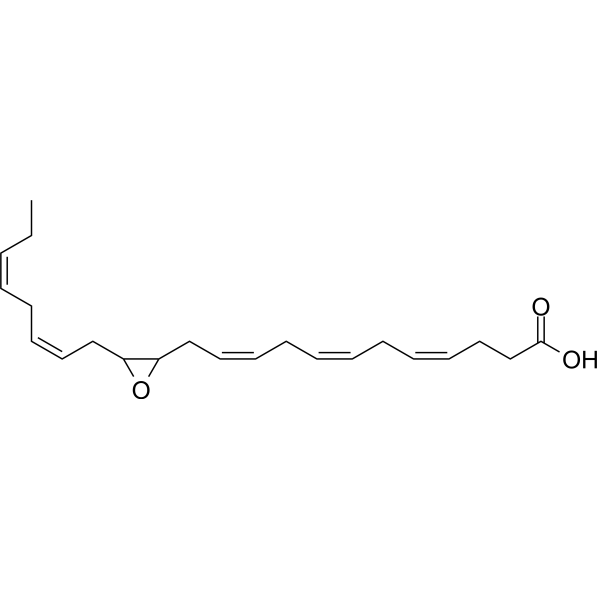
-
- HY-19886
-
|
|
Others
|
Cardiovascular Disease
|
|
F 16915, a Docosahexaenoic Acid (DHA, HY-B2167) derivative, is a potent pro-agent of DHA. F 16915 can prevent heart failure-induced atrial fibrillation .
|
-
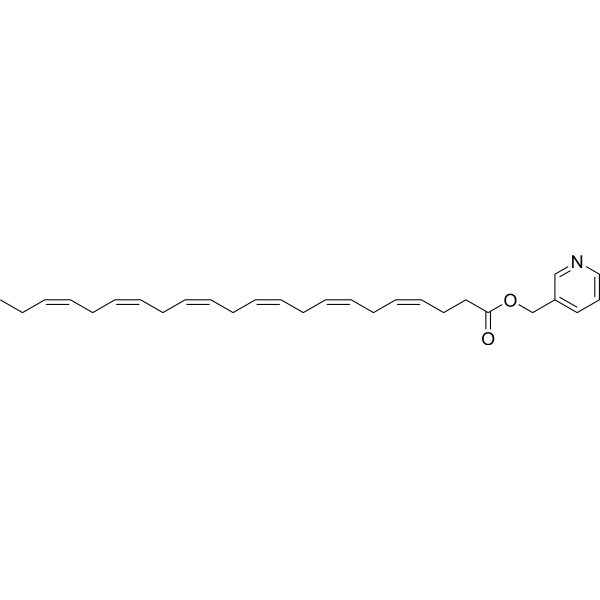
-
- HY-136540
-
|
RvD3
|
Others
|
Inflammation/Immunology
|
|
Resolvin D3 (RvD3) is a docosahexaenoic acid (DHA) derived mediator. Resolvin D3 is dysregulated in arthritis and reduces arthritic inflammation .
|
-
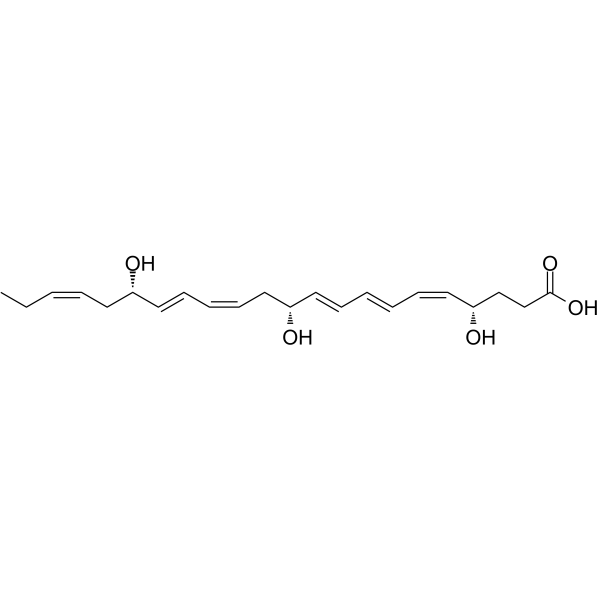
-
- HY-134997
-
|
4-oxo DHA
|
Others
|
Cancer
|
|
4-oxo Docosahexaenoic acid (4-oxo DHA) is a putative metabolite of Docosahexaenoic acid (HY-B2167) with antiproliferative and PPARγ agonist activity. It inhibits the growth of several triple negative breast cancer cell lines (MCF-10F, trMCF, bsMCF, MDA-MB-231, and BT549) at 50-100 μM, however it increased proliferation of MCF-7 cells. 4-oxo DHA binds covalently to PPARγ and activates gene transcription in luciferase reporter assays and in dendritic cells with EC50 values of approximately 8-16 μM.
|
-

-
- HY-130413
-
|
Neuroprotectin D1; NPD1
|
Endogenous Metabolite
|
Neurological Disease
|
|
Protectin D1, neuroprotectin D1 when generated by neural cells, is a member of a new family of bioactive products generated from docosahexaenoic acid. Protectin D1 is also a specialized pro-resolving mediator with potent pro-resolving and anti-inflammatory effects in vivo in several human disease models .
|
-
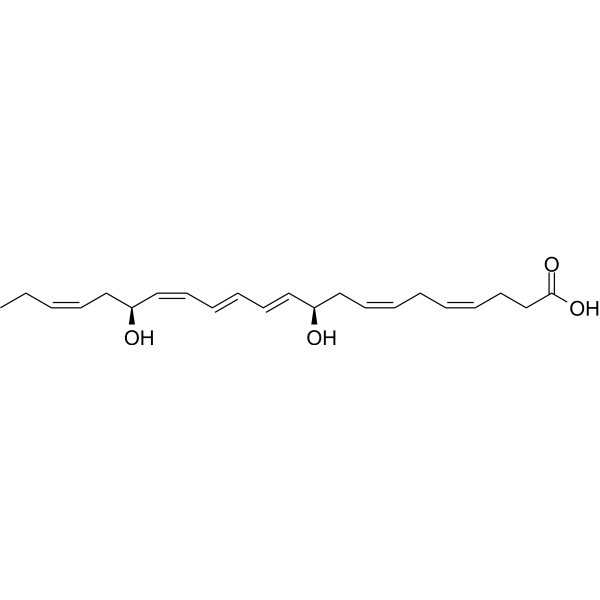
-
- HY-130238
-
|
(±)8-HDoHE; 8-hydroxy Docosahexaenoic Acid; (±)8-HDoHE
|
Endogenous Metabolite
|
Metabolic Disease
|
|
(±)8-HDHA is an autoxidation product of docosahexaenoic acid (DHA) in vitro. It is also produced from incubations of DHA in rat liver, brain, and intestinal microsomes. (±)8-HDHA is a potential marker of oxidative stress in brain and retina where DHA is an abundant polyunsaturated fatty acid.
|
-

-
- HY-130287
-
|
(±)16-HDoHE; 16-hydroxy Docosahexaenoic Acid; (±)16-HDoHE
|
Endogenous Metabolite
|
Metabolic Disease
|
|
(±)16-HDHA is an autoxidation product of docosahexaenoic acid (DHA) in vitro. It is also produced from incubations of DHA in rat liver, brain, and intestinal microsomes. (±)16-HDHA is a potential marker of oxidative stress in brain and retina where DHA is an abundant polyunsaturated fatty acid.
|
-

-
- HY-113777
-
|
22-Hydroxy Docosahexaenoic Acid; 22-OH DHA
|
Others
|
Metabolic Disease
|
|
22-HDHA is an oxidation product of docosahexaenoic acid.1 In vitro, it is formed upon incubation of rat liver microsomes with DHA and NADPH and also by the human cytochrome P450 (CYP) isoform CYP4F3B in BTI-TN-5B1-4 microsomes. Serum levels of 22-HDHA increase following dietary DHA supplementation in humans.
|
-

-
- HY-130288
-
|
(±)13-HDoHE; 13-hydroxy Docosahexaenoic Acid; (±)13-HDoHE
|
Others
|
Inflammation/Immunology
|
|
(±)13-HDHA is an autoxidation product of docosahexaenoic acid (DHA) in vitro. It is also produced from incubations of DHA in rat liver, brain, and intestinal microsomes. Fresh water hydra is shown to metabolize DHA to 13(R)-HDHA, presumably via the 11R-lipoxygenase activity. (±)13-HDHA is a potential marker of oxidative stress in brain and retina where DHA is an abundant polyunsaturated fatty acid.
|
-

-
- HY-130239
-
|
14(S)-HDoHE
|
Drug Metabolite
|
Neurological Disease
|
|
14(S)-HDHA (14(S)-HDoHE) is an oxygenation product of Docosahexaenoic acid (DHA). 14(S)-HDHA is a marker reflecting activation of a Docosahexaenoic acid carbon 14-lipoxygenation pathway .
|
-

-
- HY-120255A
-
|
|
PPAR
|
Metabolic Disease
|
|
17(S)-HDHA is a pro-resolving mediator (SPM). 17(S)-HDHA slightly activats PPARγ, PPARα and PPARδ .
|
-
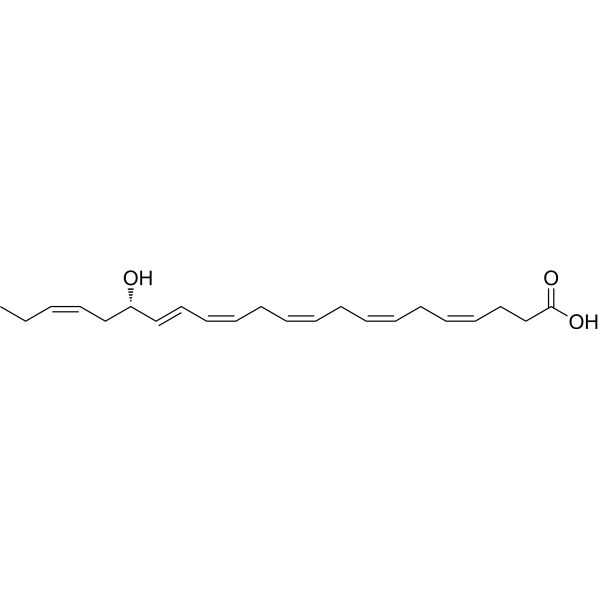
-
- HY-120312
-
|
|
Others
|
Others
|
|
PCTR3 is a Docosahexaenoic acid DHA (HY-B2167) derivative, which acts as a pro-resolving and tissue regeneration lipid mediator .
|
-
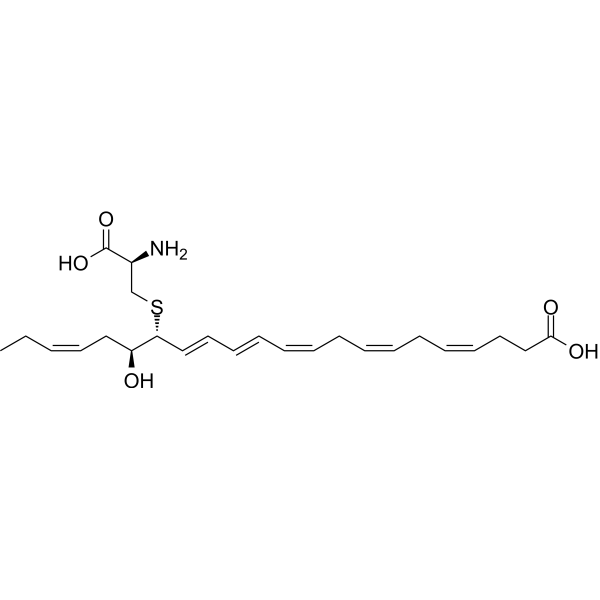
-
- HY-158623
-
-

-
- HY-119684
-
|
|
Others
|
Inflammation/Immunology
|
|
Maresin 2 is an anti-inflammatory and pro-resolving mediator from human macrophages. Maresins are a new family of anti-inflammatory and pro-resolving lipid mediators biosynthesized from docosahexaenoic acid (DHA) by macrophages .
|
-
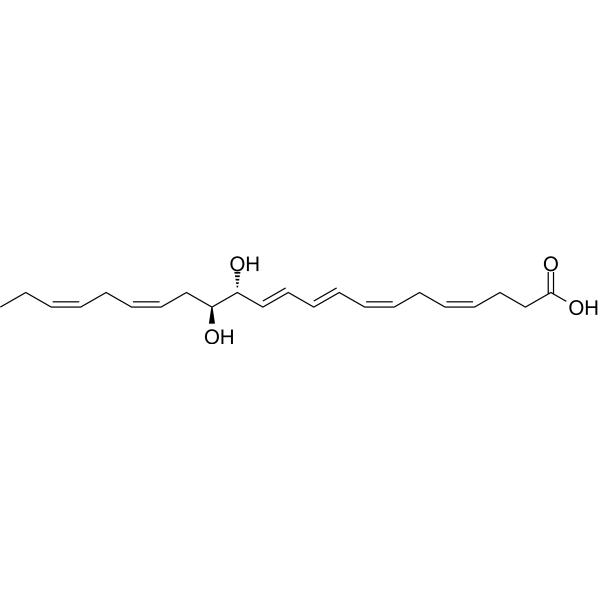
-
- HY-116663
-
|
(±)20-HDoHE
|
Endogenous Metabolite
|
Neurological Disease
|
|
(±)20-HDHA ((±)20-HDoHE) is a racemic mixture and is an autoxidation product of Docosahexaenoic acid (DHA). (±)20-HDHA is also formed by peroxidation process in human platelets and rat brain homogenate .
|
-
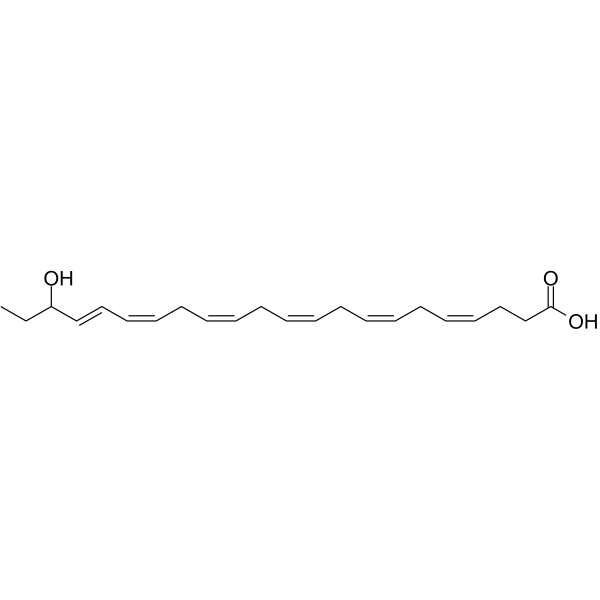
-
- HY-116429
-
|
|
Reactive Oxygen Species
|
Inflammation/Immunology
|
|
Maresin 1, produced by human Mφs from endogenous docosahexaenoic acid (DHA) and a specialized proresolving mediator, stimulates intracellular [Ca 2+] and secretion. Maresin 1 possesses anti-inflammatory activity .
|
-
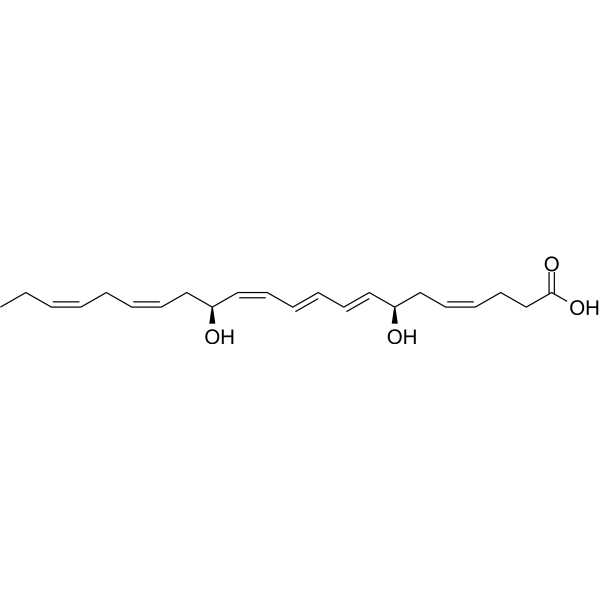
-
- HY-136540S
-
|
RvD3-d5
|
Isotope-Labeled Compounds
|
Inflammation/Immunology
|
|
Resolvin D3-d5 is the deuterium labeled Resolvin D3. Resolvin D3 (RvD3) is a docosahexaenoic acid (DHA) derived mediator. Resolvin D3 is dysregulated in arthritis and reduces arthritic inflammation[1][2].
|
-
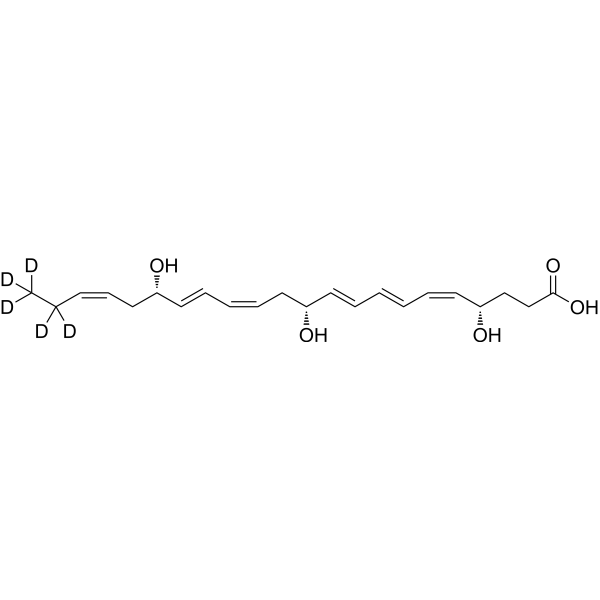
-
- HY-116429S
-
-
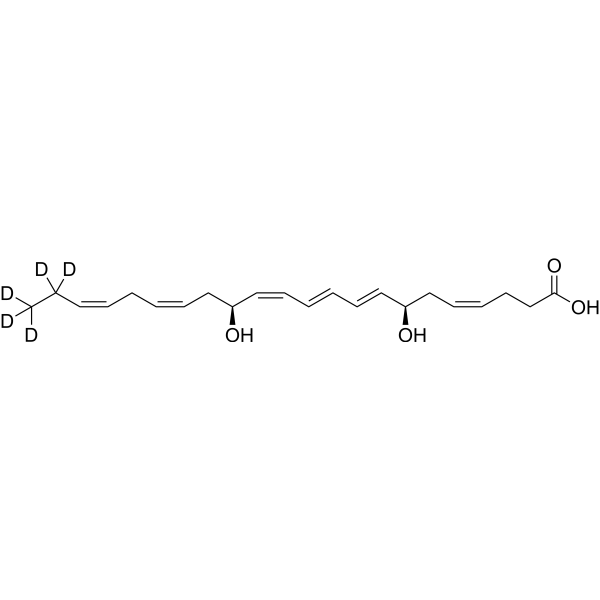
-
- HY-142974
-
|
1,2-Olein-3-Docosohexaenoin; 18:1/18:1/22:6-TG; C1OO
|
Endogenous Metabolite
|
Metabolic Disease
|
|
1,2-Dioleoyl-3-docosohexaenoyl-rac-glycerol is a triacylglycerol that contains oleic acid (HY-N1446) at the sn-1 and sn-2 positions and docosahexaenoic acid (HY-B2167) at the sn-3 position. It has been detected in human breast milk.
|
-

-
- HY-121636
-
|
RvD2
|
TRP Channel
|
Infection
Neurological Disease
Inflammation/Immunology
|
|
Resolvin D2 is a metabolite of docosahexaenoic acid (DHA), with anti-inflammatory, anti-infective activities. Resolvin D2 is a potent regulator of leukocytes and controls microbial sepsis. Resolvin D2 is a remarkably potent inhibitor of TRPV1 (IC50 = 0.1 nM) and TRPA1 (IC50 = 2 nM) in primary sensory neurons .
|
-

-
- HY-125527
-
|
RvD1
|
Endogenous Metabolite
|
Inflammation/Immunology
|
|
Resolvin D1 (RvD1), an endogenous pro-resolving mediator of inflammation, is derived from omega-3 docosahexaenoic acid during the resolution phase of acute inflammation. Resolvin D1 blocks proinflammatory neutrophil migration by regulating actin polymerization, reduces TNF-α–mediated inflammation in macrophages, and enhances phagocytosis of apoptotic cells by macrophages .
|
-
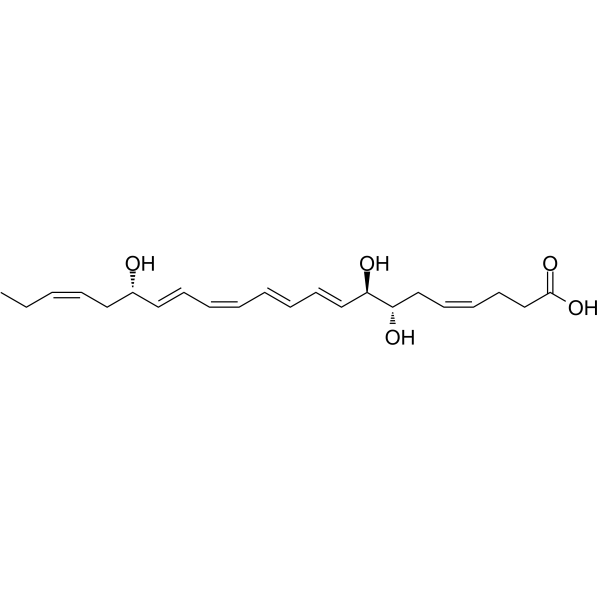
-
- HY-116124
-
|
|
Lipoxygenase
|
Others
|
|
17(S)-HpDHA is the main 15-Lipoxygenase (LOX) isoenzyme: h15-LOX-1 and h15-LOX-2 and docosahexaenoic acid (DHA). product. 17(S)-HpDHA negatively regulates epoxide synthesis via allosteric regulation. 17(S)-HpDHA also inhibits platelet aggregation with an EC50 of approximately 1 μM .
|
-
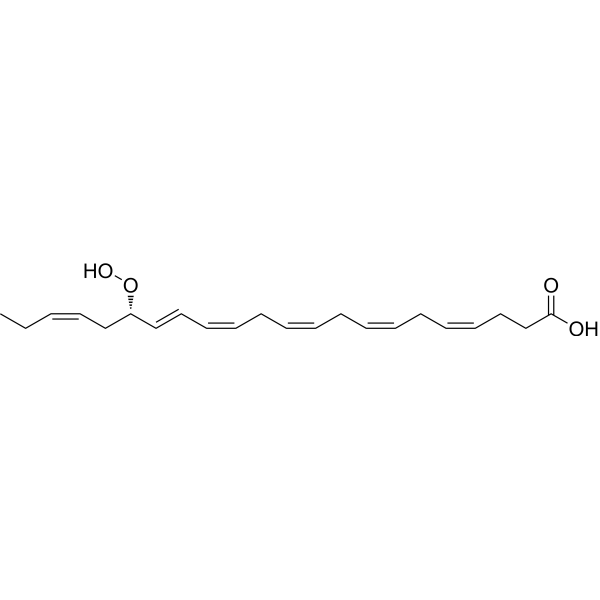
-
- HY-120255AS
-
-
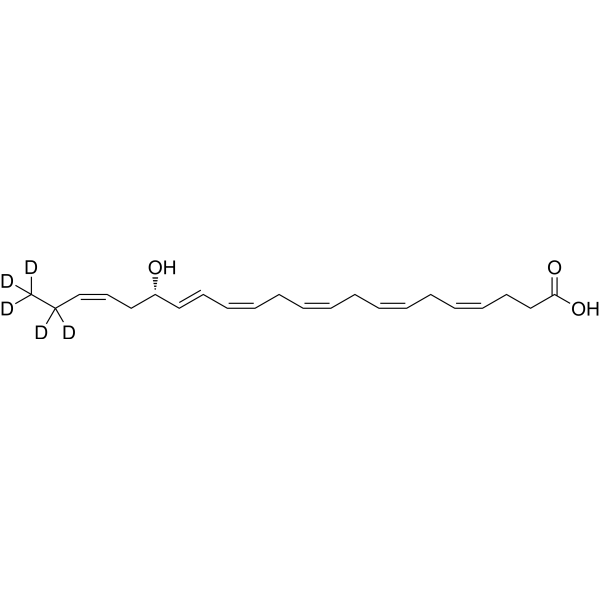
-
- HY-121636S
-
|
RvD2-d5
|
TRP Channel
|
Infection
Neurological Disease
Inflammation/Immunology
|
|
Resolvin D2-d5 is the deuterium labeled Resolvin D2. Resolvin D2 is a metabolite of docosahexaenoic acid (DHA), with anti-inflammatory, anti-infective activities. Resolvin D2 is a potent regulator of leukocytes and controls microbial sepsis. Resolvin D2 is a remarkably potent inhibitor of TRPV1 (IC50 = 0.1 nM) and TRPA1 (IC50 = 2 nM) in primary sensory neurons[1][2][3].
|
-
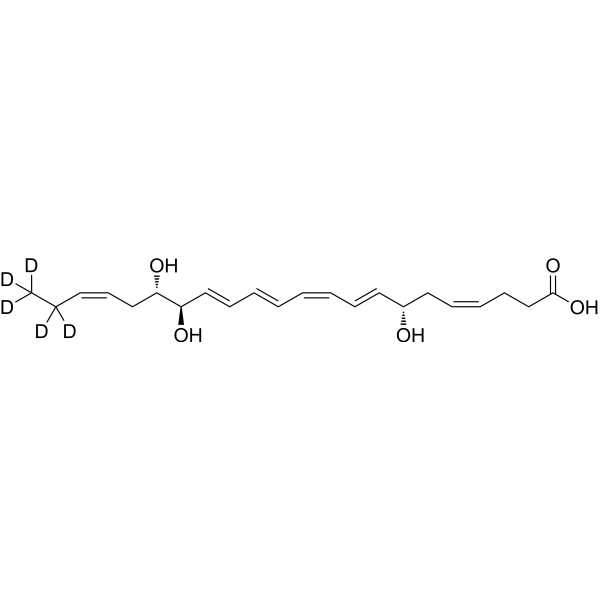
-
- HY-125527S
-
|
RvD1-d5
|
Isotope-Labeled Compounds
Endogenous Metabolite
|
Inflammation/Immunology
|
|
Resolvin D1-d5 is the deuterium labeled Resolvin D1. Resolvin D1 (RvD1), an endogenous pro-resolving mediator of inflammation, is derived from omega-3 docosahexaenoic acid during the resolution phase of acute inflammation. Resolvin D1 blocks proinflammatory neutrophil migration by regulating actin polymerization, reduces TNF-α–mediated inflammation in macrophages, and enhances phagocytosis of apoptotic cells by macrophages[1][2].
|
-
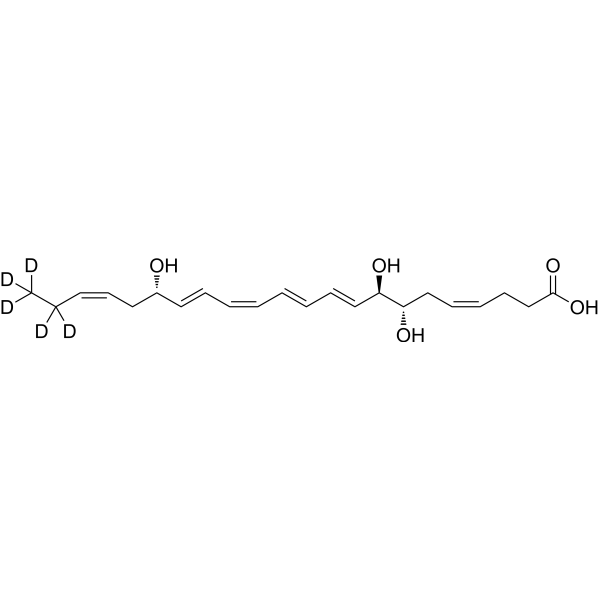
-
- HY-120978
-
|
ω-3 Arachidonic Acid methyl ester; (all-Z)-8,11,14,17-Eicosatetraenoic Acid methyl ester
|
Biochemical Assay Reagents
|
Others
|
|
omega-3 Arachidonic Acid methyl ester, mainly docosahexaenoic acid, eicosapentaenoic acid and α-Linoleic acid, represented by linoleic acid, is an essential dietary nutrient required for normal growth and development.Omega-3Methyl arachidonic acid is a rare fatty acid Omega-3Neutral fat-soluble form of arachidonic acid. Omega-3Fatty acids, as a group, were associated with reduced inflammation and autoimmune activity, as well as reduced thrombosis and platelet activation.
|
-

-
- HY-N7833
-
|
Heneicosapentaenoic Acid
|
Biochemical Assay Reagents
|
Others
|
|
Heneicosapentaenoic Acid (HPA) is a 21:5 omega-3 fatty acid found in trace amounts in the green alga B. pennata and in fish oils. Its chemical composition is similar to eicosapentaenoic acid (EPA), except that a carbon is extended at the carboxy terminus, placing the first double bond at the δ6 position. HPA can be used to study the importance of double bond position in omega-3 fatty acids. It incorporates phospholipids and triacylglycerols in vivo with the same efficiency as EPA and docosahexaenoic acid, and exhibits a strong inhibitory effect on the synthesis of arachidonic acid from linoleic acid. HPA is a poor substrate for prostaglandin H synthase (PGHS) (cyclooxygenase) and 5-lipoxygenase, but retains the ability to rapidly inactivate PGHS.
|
-
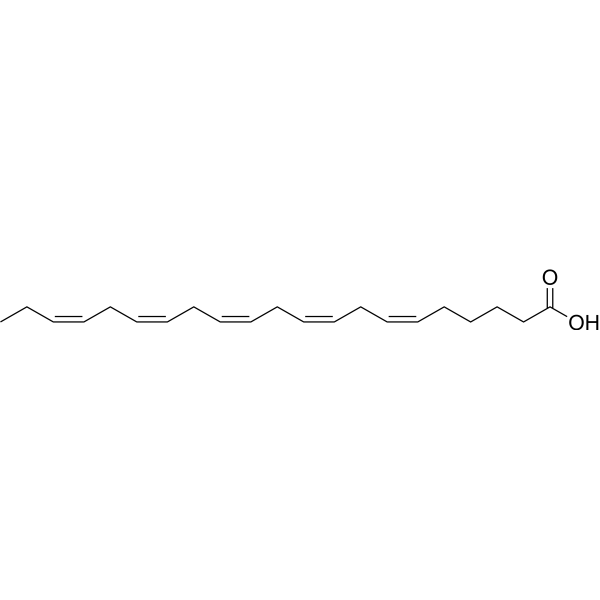
| Cat. No. |
Product Name |
Type |
-
- HY-120978
-
|
ω-3 Arachidonic Acid methyl ester; (all-Z)-8,11,14,17-Eicosatetraenoic Acid methyl ester
|
Biochemical Assay Reagents
|
|
omega-3 Arachidonic Acid methyl ester, mainly docosahexaenoic acid, eicosapentaenoic acid and α-Linoleic acid, represented by linoleic acid, is an essential dietary nutrient required for normal growth and development.Omega-3Methyl arachidonic acid is a rare fatty acid Omega-3Neutral fat-soluble form of arachidonic acid. Omega-3Fatty acids, as a group, were associated with reduced inflammation and autoimmune activity, as well as reduced thrombosis and platelet activation.
|
-
- HY-N7833
-
|
Heneicosapentaenoic Acid
|
Biochemical Assay Reagents
|
|
Heneicosapentaenoic Acid (HPA) is a 21:5 omega-3 fatty acid found in trace amounts in the green alga B. pennata and in fish oils. Its chemical composition is similar to eicosapentaenoic acid (EPA), except that a carbon is extended at the carboxy terminus, placing the first double bond at the δ6 position. HPA can be used to study the importance of double bond position in omega-3 fatty acids. It incorporates phospholipids and triacylglycerols in vivo with the same efficiency as EPA and docosahexaenoic acid, and exhibits a strong inhibitory effect on the synthesis of arachidonic acid from linoleic acid. HPA is a poor substrate for prostaglandin H synthase (PGHS) (cyclooxygenase) and 5-lipoxygenase, but retains the ability to rapidly inactivate PGHS.
|
| Cat. No. |
Product Name |
Category |
Target |
Chemical Structure |
| Cat. No. |
Product Name |
Chemical Structure |
-
- HY-B2167S
-
|
|
|
Docosahexaenoic acid-d5 is the deuterium labeled Docosahexaenoic Acid. Docosahexaenoic Acid (DHA) is an omega-3 fatty acid abundantly present brain and retina. It can be obtained directly from fish oil and maternal milk.
|
-

-
- HY-B2167S1
-
|
|
|
Docosahexaenoic acid- 13C22 is the 13C labeled Docosahexaenoic acid[1]. Docosahexaenoic Acid (DHA) is an omega-3 fatty acid abundantly present brain and retina. It can be obtained directly from fish oil and maternal milk[2][3][4][5][6].
|
-

-
- HY-107343S
-
|
|
|
Docosahexaenoic acid ethyl ester-d5 is the deuterium labeled Docosahexaenoic acid ethyl ester. Docosahexaenoic acid ethyl ester (Ethyl docosahexaenoate) is a 90% concentrated ethyl ester of docosahexaenoic acid manufactured from the microalgal oil. Docosahexaenoic acid ethyl ester enhances 6-hydroxydopamine-induced neuronal damage by induction of lipid peroxidation in mouse striatum. Docosahexaenoic acid (DHA) is a key component of the cell membrane, and its peroxidation is inducible due to the double-bond chemical structure. Docosahexaenoic acid has neuroprotective effects[1][2].
|
-

-
- HY-107343S1
-
|
|
|
Docosahexaenoic acid ethyl ester-d5-1 is the deuterium labeled Docosahexaenoic acid ethyl ester. Docosahexaenoic acid ethyl ester (Ethyl docosahexaenoate) is a 90% concentrated ethyl ester of docosahexaenoic acid manufactured from the microalgal oil. Docosahexaenoic acid ethyl ester enhances 6-hydroxydopamine-induced neuronal damage by induction of lipid peroxidation in mouse striatum. Docosahexaenoic acid (DHA) is a key component of the cell membrane, and its peroxidation is inducible due to the double-bond chemical structure. Docosahexaenoic acid has neuroprotective effects[1][2][3].
|
-

-
- HY-101541S
-
|
|
|
Docosahexaenoic acid-d5 methyl ester is the deuterium labeled Docosahexaenoic Acid methyl ester. Docosahexaenoic Acid methyl ester is a methylated docosahexaenoic acid analog which can be intercalated into membrane phospholipids without being oxidized or hydrolyzed[1][2].
|
-

-
- HY-101541S1
-
|
|
|
Docosahexaenoic acid- 13C22 methyl ester is the 13C22 labeled Docosahexaenoic acid methyl ester (HY-101541)[1].
|
-

-
- HY-136540S
-
|
|
|
Resolvin D3-d5 is the deuterium labeled Resolvin D3. Resolvin D3 (RvD3) is a docosahexaenoic acid (DHA) derived mediator. Resolvin D3 is dysregulated in arthritis and reduces arthritic inflammation[1][2].
|
-

-
- HY-116429S
-
|
|
|
Maresin 1-d5 is the deuterium labeled Maresin 1. Maresin 1, produced by human Mφs from endogenous docosahexaenoic acid (DHA) and a specialized proresolving mediator, stimulates intracellular [Ca2+] and secretion. Maresin 1 possesses anti-inflammatory activity[1][2][3].
|
-

-
- HY-120255AS
-
|
|
|
17(S)-HDHA-d5 is the deuterium labeled 17(S)-HDHA[1].
|
-

-
- HY-121636S
-
|
|
|
Resolvin D2-d5 is the deuterium labeled Resolvin D2. Resolvin D2 is a metabolite of docosahexaenoic acid (DHA), with anti-inflammatory, anti-infective activities. Resolvin D2 is a potent regulator of leukocytes and controls microbial sepsis. Resolvin D2 is a remarkably potent inhibitor of TRPV1 (IC50 = 0.1 nM) and TRPA1 (IC50 = 2 nM) in primary sensory neurons[1][2][3].
|
-

-
- HY-125527S
-
|
|
|
Resolvin D1-d5 is the deuterium labeled Resolvin D1. Resolvin D1 (RvD1), an endogenous pro-resolving mediator of inflammation, is derived from omega-3 docosahexaenoic acid during the resolution phase of acute inflammation. Resolvin D1 blocks proinflammatory neutrophil migration by regulating actin polymerization, reduces TNF-α–mediated inflammation in macrophages, and enhances phagocytosis of apoptotic cells by macrophages[1][2].
|
-

Your information is safe with us. * Required Fields.
Inquiry Information
- Product Name:
- Cat. No.:
- Quantity:
- MCE Japan Authorized Agent:





















































